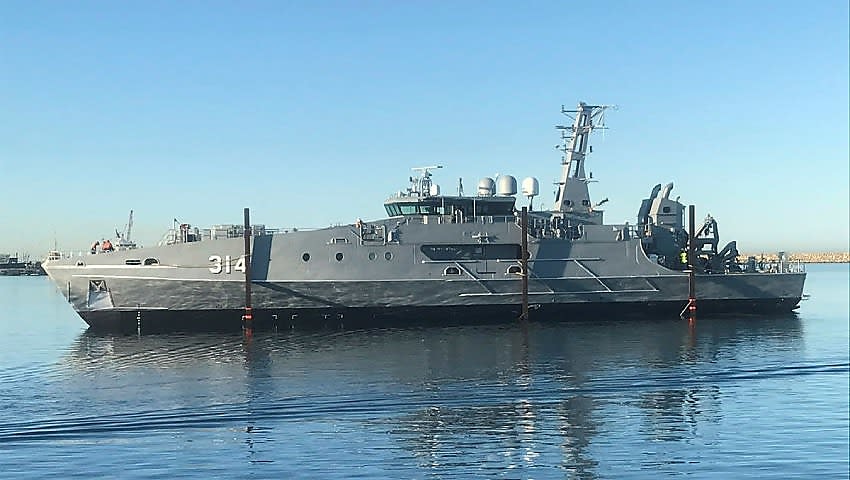Carrier HMS Prince of Wales Under NATO Command in Major Exercise – DZIRHAN MAHADZIR FEBRUARY 26, 2024 3:38 PM
Naval Striking and Support Forces NATO (STRIKFORNATO) has assumed command of the multinational U.K. carrier strike group (CSG) headed by carrier HMS Prince of Wales (R09) for its participation in NATO exercise Steadfast Defender 2024, according to a social media post by the command on Tuesday.
“This transfer of authority to STRIKFORNATO/Naval Striking and Support Forces NATO demonstrates the Alliance’s ability to integrate the high-end capabilities of a British Carrier, its strike group escorts, and embarked air wing during a series of meticulously planned maritime security activities and training perfectly aligned with the Deterrence and Defence family of Allied collective plans,” read the post.
Prince of Wales is making its first operational deployment leading the U.K. CSG. Originally, HMS Queen Elizabeth (R08) was scheduled to head the deployment before problems with its propeller forced a change of plans.
The Steadfast Defender 2024 deployment marks the first time Prince of Wales is operating with a complete embarked air group consisting of F-35B Lightning fighters from No. 617 “Dambusters” Squadron, submarine hunting and airborne early warning Merlin Mk2 helicopters from RNAS Culdrose and battlefield Wildcat helicopters of 847 Naval Air Squadron. The carrier’s prior deployments consisted of fewer aircraft and helicopters, which were embarked for trials. The U.K. has not released the number of F-35Bs embarked, though it is expected to be fewer than the 18 embarked on Queen Elizabeth during the CSG 21 deployment..
Along with carrier Prince of Wales, the U.K. CSG home contingent consists of Royal Navy frigate HMS Portland (F79), along with Royal Fleet Auxiliary (RFA) fleet oilers RFA Tidespring (A136) and RFA Tidesurge (A138). Its multinational contingent consists of U.S. Navy destroyer USS Paul Ignatius (DDG-117), Royal Canadian Navy frigate HMCS Charlottetown (FFH339), Spanish Navy frigate SNS Cristobal Colon (F105) and Royal Danish Navy frigate HDMS Niels Juel (F363) and patrol vessel HDMS Hvidbjørnen (F360).
A Royal Navy release on Tuesday stated that most of the CSG had now linked up and were conducting integration drills as part of the Joint Warrior exercise, which runs from Feb.24 – Mar. 3, before moving on to participate in Exercise Nordic Response, the maritime portion of Steadfast Defender, which begins on Mar. 5. Approximately 40 ships from more than two dozen countries will be involved in Nordic Response.
Steadfast Defender 2024 is the largest NATO exercise since the Cold War, with approximately 90,000 troops from all 31 NATO member states, as well as partner Sweden, participating. The exercise began at the end of January and set to end on May 31. The first phase of the exercise focuses on transatlantic reinforcement with the strategic deployment of North American forces across the Atlantic to continental Europe. This phase includes live maritime exercises and amphibious assault training in the North Atlantic and Arctic seas. The second phase focuses on multidomain exercises across Europe and is also testing rapid deployment of troops and equipment across borders within the NATO alliance.
NATO has not released a full list of ships participating in the exercise but several ships are known, including amphibious dock landing ship USS Gunston Hall (LSD-44), which arrived in Harstad, Norway, on Feb. 21, according to a Pentagon release. Gunston Hall is embarking Finnish and Swedish forces in Harstad to conduct amphibious training exercises in Norway, according to the release. It also will join with Italian Navy aircraft carrier ITS Giuseppe Garibaldi (551), amphibious transport dock San Giorgio (L9892) and several escort ships to form an amphibious task force. Several ships from Standing NATO Maritime Group 1 (SNMG-1) also will take part in the exercise, namely Spanish Navy frigate SNS Almirante Juan de Borbón (F102) and fleet oiler SNS Cantabria (A15), German Navy Fleet oiler FGS Bonn (A1413) and Italian Navy frigate ITS Luigi Rizzo (F595). A French attack submarine is also participating in the exercise.
from Blogger https://ift.tt/ci3gVd8
via IFTTT February 27, 2024 at 11:59AM See all posts in full – click here https://jcsnavyandmilitarynews.blogspot.com/




 FS
FS















